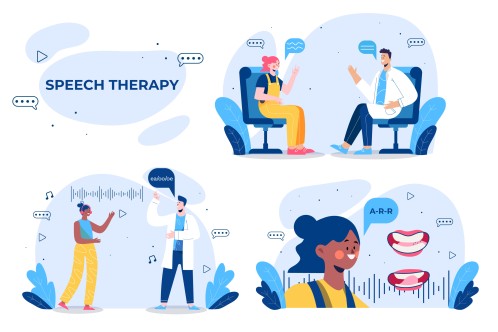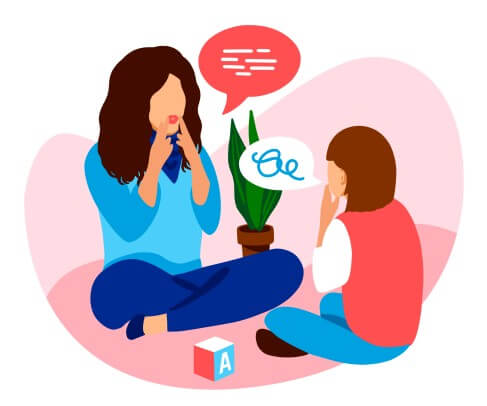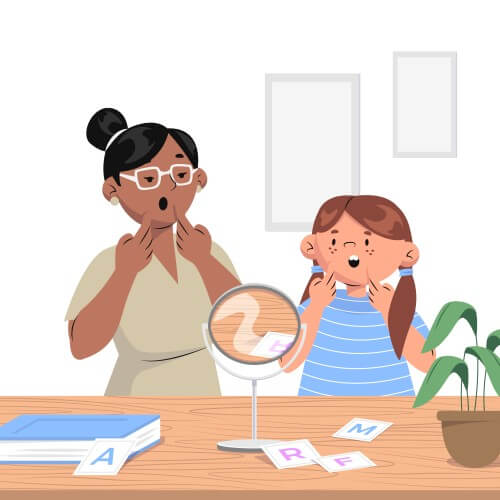What do Speech and Language therapists do?
By Rajini D
Last Updated: September 23, 2023
Speech and language development is essential to a child’s overall growth and well-being. However, some children may experience difficulties developing these skills, significantly impacting their communication ability. This is where speech and language therapists play a vital role. Speech and language therapy is governed internationally by the International Association of Communication Science and Disorders.
Understanding Speech and Language Disorders:
Speech and language disorders encompass a wide range of difficulties affecting a child’s communication ability. These disorders manifest in several ways, including articulation and phonological disorders, language delays, stuttering, and voice disorders. Speech and language therapists are highly trained in assessing, diagnosing, and treating these disorders.
The Role of Speech and Language Therapists
Speech and language therapists work with children of all ages, from infants to teenagers, experiencing communication difficulties. Our primary goal is to help children develop practical communication skills, enabling them to express themselves, understand others, and engage in social interactions. Let’s delve into the specific tasks and responsibilities of these therapists
Discover the key fine motor skills development activities that support speech and language therapy.

1. Assessment and Diagnosis:
Therapists conduct comprehensive speech assessments to identify a child’s specific communication challenges. They use standardized tests, informal observations, and interviews with parents and caregivers to gather relevant information. This evaluation helps therapists create personalized treatment plans tailored to each child’s needs.
Learn about the speech and language milestones from 0 to 12 months to understand the early signs of communication disorders.
2. Creating Treatment Plans
Speech and language therapists develop individualized treatment plans based on the assessment results. These plans outline specific goals and objectives to address the child’s areas of difficulty. The therapy goals may focus on improving speech articulation, expanding vocabulary, enhancing grammar and sentence structure, enhancing social communication skills, or addressing specific disorders such as stuttering or voice disorders.
Explore strategies for overcoming stuttering and the benefits of AAC speech therapy for non-verbal children.
3. Therapy Sessions
Therapists conduct regular sessions to work directly with the child. These sessions employ various techniques and activities to target the specific goals outlined in the treatment plan. Therapy sessions can be conducted one-on-one, in small groups, or even in a classroom setting, depending on the child’s needs and the therapist’s recommendations.
Find out how speech therapy at home can complement professional therapy sessions.
Intervention Strategies Employed by Speech and Language Therapists
| Strategy | Description | Examples / Applications |
|---|---|---|
| Evidence-Based Techniques | Utilizing proven methods to enhance communication skills, tailored to each child’s needs. | – Specific language intervention programs – Speech sound intervention techniques – Fluency shaping strategies |
| Play-Based Activities | Incorporating play to engage children and facilitate learning and development of communication skills. | – Role-playing games to practice conversational skills – Storytelling with toys to enhance narrative skills – Interactive games to improve phonological awareness |
| Technology-Assisted Interventions | Using technology, such as apps and software, to support and enhance therapy outcomes. | – Speech therapy apps for articulation practice – Interactive software for language development – Augmentative and alternative communication (AAC) devices for non-verbal children |
| Visual Aids | Employing pictures, videos, and other visual materials to aid in understanding and communication. | – Picture exchange communication systems (PECS) for initiating communication – Video modeling for social skills training – Visual schedules to support understanding of daily routines |
| Collaborative Efforts | Working with parents, teachers, and other professionals to support the child’s communication development. | – Training sessions for parents on how to reinforce language skills at home – Consultation with teachers to integrate communication goals in the classroom – Interdisciplinary meetings with other professionals (e.g., psychologists, occupational therapists) to coordinate care |
4. Language and Communication Enhancement
Speech and language therapists utilize evidence-based techniques to enhance language and communication skills in children. They incorporate activities that promote vocabulary development, sentence formation, comprehension, and storytelling. Additionally, they may use visual aids, play-based activities, and technology-assisted interventions to engage children and facilitate their progress.
Enhance your child’s learning with tips on developing good learning habits
5. Articulation and Phonological Training
Therapists employ techniques to improve speech sound production for children with articulation and phonological disorders. These may include tongue and lip exercises, modeling correct articulation, and providing auditory feedback. Therapists work closely with children to help them accurately pronounce sounds, words, and sentences.
Understand the role of oral motor exercises in improving speech sound production.
6. Fluency and Stuttering Intervention
Children who stutter require specialized interventions to enhance their fluency and reduce disfluencies. Speech and language therapists employ controlled fluency, breathing exercises, relaxation techniques, and speech modification approaches to help children develop smoother and more fluent speech patterns.
Read about aphasia and apraxia unveiled for a deeper understanding of complex speech disorders.
7. Voice Therapy
Children with voice disorders characterized by abnormal pitch, loudness, or voice quality can benefit from voice therapy. Speech and language therapists provide exercises to improve vocal hygiene, vocal cord function, and vocal resonance. They may also guide proper voice projection and vocal techniques to minimize strain and prevent vocal cord damage.
Learn about the speech chain and its importance in voice therapy.
8. Social Communication Skills:
Speech and language therapists play a crucial role in improving children’s social communication skills. They help children understand non-verbal cues, interpret social situations, engage in turn-taking, and develop appropriate conversational skills. Therapists often collaborate with parents, teachers, and other professionals to create supportive environments that encourage effective communication and social interaction.
Roles and Responsibilities of Speech and Language Therapists
| Task | Description |
|---|---|
| Assessment and Diagnosis | Conducting evaluations to identify communication challenges and creating personalized treatment plans. |
| Creating Treatment Plans | Developing tailored plans with specific goals to address communication difficulties. |
| Therapy Sessions | Direct work with the child through various techniques and activities to achieve therapy goals. |
| Language and Communication Enhancement | Using evidence-based techniques to enhance language skills, including vocabulary and sentence structure. |
| Articulation and Phonological Training | Techniques to improve speech sound production, including exercises and auditory feedback. |
| Fluency and Stuttering Intervention | Employing strategies to enhance fluency and reduce stuttering through exercises and speech modification. |
| Voice Therapy | Providing exercises to improve vocal function and quality for those with voice disorders. |
| Social Communication Skills | Helping children develop social communication skills, such as understanding non-verbal cues and conversational skills. |
Explore strategies for navigating online speech therapy for non-verbal children and enhancing social communication.
When is speech therapy performed?
Speech therapy is performed based on individuals with communication disorders’ specific needs and circumstances. The timing and frequency of speech therapy sessions depend on various factors, including the age of the individual, the severity and nature of the communication disorder, and the recommendations of the speech and language therapist (SLT) or healthcare professional involved. Here, we’ll elaborate on when speech therapy is commonly performed in different contexts:
Consider the benefits of online speech therapy and how it compares to in-person sessions.

1. Early Intervention:
For infants and young children, early intervention is crucial. Speech therapy may begin as early as a few months old if there are concerns about their communication development. The early intervention identifies and addresses delays or difficulties in speech, language, and overall communication skills. It typically involves working closely with parents and caregivers to provide strategies and techniques that can be integrated into the child’s daily routines and activities.
Discover why early identification warning signs in child development are critical for effective intervention
2. School-Age Children:
Speech therapy is often provided to school-age children who experience challenges in speech production, language comprehension, and expression, fluency (such as stuttering), voice quality, or social communication skills. These sessions may be conducted within the school setting by our SLT’s or as part of a collaborative effort between the school and external therapy providers. The frequency and duration of therapy sessions can vary depending on the severity of the disorder and the child’s needs. In some cases, therapy may be integrated into the child’s academic schedule, while in others, it may occur outside school hours.

3. Adolescents and Adults:
Speech therapy is not limited to children, as adolescents and adults may also require intervention for communication disorders. Common reasons for seeking therapy in this age group include articulation difficulties, language disorders, voice disorders, fluency disorders, and communication challenges resulting from neurological conditions, strokes, or traumatic brain injuries. Therapy sessions may be conducted in various settings, such as clinics, hospitals, rehabilitation centers, or private practices. The frequency and duration of therapy will be determined by the individual’s needs, goals, and the recommendations of the SLT.
4. Post-Surgical or Medical Intervention:
Speech therapy may be recommended after surgeries or medical interventions that affect speech, language, or swallowing. For example, individuals undergoing cleft palate repair or laryngeal surgery may benefit from therapy to optimize speech production and voice quality. Additionally, individuals with swallowing difficulties (dysphagia) may require therapy to regain safe and efficient swallowing function. The timing and duration of therapy in these cases will depend on the specific medical situation and the treatment professionals’ recommendations.
It’s important to note that the frequency and duration of speech therapy sessions can vary widely and are individualized to each person’s needs. Some individuals may require more intensive therapy sessions multiple times weekly, while others may benefit from less frequent sessions. The progress made during therapy is regularly assessed, and adjustments to the treatment plan are made as needed.
Conclusion
At Wellness Hub, Speech and language therapists are dedicated professionals who significantly impact children’s communication abilities. Our expertise, assessment techniques, personalized treatment plans, and evidence-based interventions help children overcome speech and language difficulties. As we prioritize comprehensive wellness, we invite you to explore the services of these dedicated professionals, knowing that they are an essential part of what makes Wellness Hub a trusted and valuable resource for your well-being journey.
Freuently Asked Questions:
1. What is speech and language therapy and who needs it?
Speech and language therapy is a specialized field focused on assessing, diagnosing, and treating communication disorders in individuals of all ages. It’s designed for anyone experiencing difficulties with speech, language, voice, fluency, or social communication. These challenges can affect the ability to communicate effectively, impacting personal, academic, and professional areas of life.
2. What are the common speech and language disorders in children?
Common speech and language disorders include articulation and phonological disorders, language delays, stuttering, voice disorders, and difficulties with social communication skills. Each disorder affects a child’s ability to communicate clearly and effectively.
3. What do speech and language therapists do?
Speech and language therapists assess and treat individuals with speech, language, voice, and communication difficulties. They create personalized treatment plans, conduct therapy sessions, and work collaboratively with families, educators, and other professionals to support the individual’s communication needs.
4. How can speech therapy benefit children with communication disorders?
Speech therapy offers numerous benefits, including improved articulation, enhanced language abilities, better fluency, and more effective social communication skills. It empowers children to express themselves more clearly, understand others, and participate more fully in social and academic settings.
5. When should speech therapy begin for a child with communication difficulties?
Early intervention is key. Speech therapy can start as early as a few months old if there are signs of communication difficulties. The earlier therapy begins, the better the outcomes for developing speech and language skills.
6. How long does speech therapy take to show results?
The duration of speech therapy varies depending on the individual’s needs, the severity of the disorder, and the frequency of therapy sessions. While some improvements can be observed in a few months, ongoing therapy may be necessary for more significant progress.
7. What techniques do speech therapists use?
Speech therapists use a variety of techniques, including play-based activities, evidence-based intervention strategies, technology-assisted interventions, visual aids, and collaborative efforts with families and educators to enhance communication skills.
8. Can speech therapy really make a difference?
Yes, speech therapy can significantly impact an individual’s ability to communicate. It helps improve speech clarity, language development, understanding and use of social cues, and overall communication skills. Success varies from person to person but can profoundly affect quality of life and confidence.
9. What can parents do to support speech therapy at home?
Parents can play a crucial role in reinforcing speech therapy at home by engaging in regular, targeted communication activities, reading together, practicing speech and language exercises provided by the therapist, and creating a supportive and encouraging environment for practice and progress.
10. How often should speech therapy sessions be conducted?
The frequency of speech therapy sessions varies based on the individual’s needs, the severity of the communication disorder, and specific goals set by the speech therapist. Some individuals may benefit from sessions multiple times a week, while others may see progress with weekly sessions. The speech therapist will recommend a schedule tailored to each person’s unique situation.
About the Author:
Rajini, Speech-Language Pathologist:
Rajini is a dedicated Speech-Language Pathologist with a focus on developmental speech and language disorders in children and rehabilitation in adults. With a passion for helping each individual find their voice, Rajini brings a wealth of experience and a heartfelt approach to therapy. At Wellness Hub, she’s part of a team that values innovation, compassion, and results-driven practices.
Book your Free Consultation Today
Parent/Caregiver Info:
Client’s Details:
* Error Message








